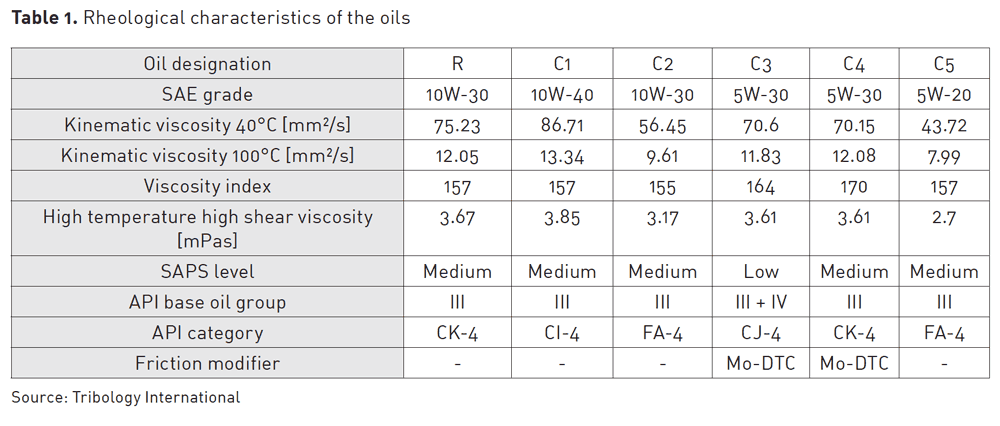
As thin as water: Maximizing fuel economy by thinning lubricating oils
By Dr. Raj Shah, Dr. Mathias Woydt, Isaac Kim
With growing concern over greenhouse gas emissions as well as the environmental problems associated with the transportation and automotive industries, nearly all countries in the world have set fuel economy regulations in order to reduce fuel consumption and emissions.
As a result, there has been an increasing amount of research to improve vehicle emissions and fuel efficiency before the deadlines set by these regulations, notably through the thinning and modification of lubricating oils.
Although lubricating oils provide only a marginal ~1% increase in fuel economy depending on viscosity grade, with an estimated 135 million passenger vehicles contributing 29% of all greenhouse gas emissions in the U.S. alone, there is immense potential to reduce CO2 emissions.
The main purpose of any lubricating oil is to reduce friction between moving parts of an engine, to prevent failures and reduce wear. The reduction of friction is related to these lubrication regimes:
- Under mixed/boundary lubrication, additives, such as friction modifiers (FM) are effective, whereas
- Under hydrodynamic lubrication, viscosity and viscosity index determine friction.
All formulation strategies must consider both lubrication regimes.
Friction reduction is possible due to oil viscosity and especially under transient operations, by viscosity index, which is a measure of a fluid’s change in viscosity relative to temperature change.
 While lubrication is vital for the engine, lubricating oils also provide a number of other benefits. Lubricating oils clean the engine by capturing contaminants (soot and wear particles) and keeping particulates in suspension until filtered or removed, cool the engine by absorbing and distributing heat until it is eventually dispersed, and protect the engine by preventing corrosion and oxidation caused by organic acids formed within the engine. These beneficial properties of lubricating oils vary with both viscosity and oil film thickness. For instance, lowering the viscosity reduces viscous drag and improves lubrication, yet thins the oil film decreasing the cleaning, cooling, and protective ability of the lubricating oil against wear and scuffing. Another drawback of low viscosity oils is their NOACK volatility, because the molar mass of the base oil backbone lowers with reduced viscosity while the evaporation loss of the lubricating oil increases. Thus, it is important to balance the properties of lubricating oils such that the maximum fuel efficiency is achieved, while the integrity of the engine is maintained.
While lubrication is vital for the engine, lubricating oils also provide a number of other benefits. Lubricating oils clean the engine by capturing contaminants (soot and wear particles) and keeping particulates in suspension until filtered or removed, cool the engine by absorbing and distributing heat until it is eventually dispersed, and protect the engine by preventing corrosion and oxidation caused by organic acids formed within the engine. These beneficial properties of lubricating oils vary with both viscosity and oil film thickness. For instance, lowering the viscosity reduces viscous drag and improves lubrication, yet thins the oil film decreasing the cleaning, cooling, and protective ability of the lubricating oil against wear and scuffing. Another drawback of low viscosity oils is their NOACK volatility, because the molar mass of the base oil backbone lowers with reduced viscosity while the evaporation loss of the lubricating oil increases. Thus, it is important to balance the properties of lubricating oils such that the maximum fuel efficiency is achieved, while the integrity of the engine is maintained.
With increasing regulations and nearing deadlines, the automotive industry is forced to make swift decisions on how to reduce carbon dioxide (CO2) emissions. Thus, researchers have found a simple means to improve fuel efficiency via the optimization of lubricating oils. CO2 emissions in internal combustion engines (ICE) can be reduced by lower viscosity oils. It is then possible to improve the fuel economy of older models without replacing its engine.
SAE J300, a standard that defines the viscometric properties of monograde and multigrade engine oils, added a lower viscosity grade SAE 16 with High Temperature High Shear (HTHS) viscosity of > 2.3 mPas in 2013. SAE 12 with HTHS viscosity of > 2.0 mPas and SAE 8 with HTHS viscosity of > 1.7 mPas followed soon after in 2015. Recently, a new viscosity grade, SAE 4 with HTHS viscosity of > 1.4 mPas, has been proposed.
For comparison purposes, the dynamic viscosity of water at 20°C is 1 mPas. The fluidity of ultra-low viscosity engine oils at 100°C is now inching closer to that of water at 20°C. Oil film thickness depends on viscosity and the pressure-viscosity coefficient, of which the latter has a greater influence on hydrocarbons, esters, and PAGs by a factor of 10, as compared to water. The main driving force for lower viscosity engine oils is to reduce hydrodynamic friction and ultimately improve the average fuel economy of automobiles.
A study¹ in the SAE International Journal of Fuels and Lubricants, 2016, by Ishikawa et al. compared SAE 0W-20 and SAE 0W-16 lubricating oils created from a Group III base stock and three sets of additive technologies made up of an ILSAC GF-5 additive package, appropriate viscosity index improver, and pour point depressants. The study utilized the Sequence VID (ASTM D7589) method to test each of the lubricating oils’ fuel economy improvement (FEI) compared with the baseline oil SAE 20W-30 before and after an oil aging phase. The results showed that prior to oil aging, SAE 0W-20 oils showed a 2.57% FEI sum, passing the ILSAC GF-5 requirement of the highest minimum FEI of 2.6%. After the oil aging phase, the SAE 0W-20 oils showed a 1.13% FEI sum, which did not pass the 1.12% highest minimum ILSAC GF-5 requirement; yet, more than half of the oils tested passed the requirement, proving these lubricating oil mixtures meet the base requirement with a minimum 50% probability. The study further showed that the SAE 0W-16 oils improved the FEI sum before oil aging by 0.24% and the FEI sum after oil aging by 0.14%. This improvement demonstrates that with current research, a minimum increase of 2.81% FEI sum before oil aging and 1.27% FEI sum after oil aging is possible by simply lowering the viscosity of the lubricating oil to the new SAE 0W-16 viscosity grade.
 Furthermore, a research paper² in Tribology international, October 2019, by Tormos et al. verified the fuel economy improvement of vehicles under stationary and real driving conditions with decreasing oil viscosity. The study consisted of five lubricating oil formulations labeled C1-C5 shown in Table 1 compared to a reference lubricating oil, labeled R, at 17 different test points covering different working zones at four engine speeds and one test point for idle conditions.
Furthermore, a research paper² in Tribology international, October 2019, by Tormos et al. verified the fuel economy improvement of vehicles under stationary and real driving conditions with decreasing oil viscosity. The study consisted of five lubricating oil formulations labeled C1-C5 shown in Table 1 compared to a reference lubricating oil, labeled R, at 17 different test points covering different working zones at four engine speeds and one test point for idle conditions.
Utilizing a stationary 3-litre diesel engine, fuel consumption dropped as a result of lower HTHS viscosity, and all oil formulations with lower HTHS viscosity than the reference oil showed lower fuel consumption. These tests clearly illustrate that the effects of viscous drag within an engine degrade when shifting from hydrodynamic lubrication to mixed or boundary lubrication as well as the benefits low HTHS viscosity provides by minimizing viscous drag during hydrodynamic lubrication conditions.
Increasing the HTHS viscosity showed an overall increase in fuel consumption at low to medium loads and medium engine speeds as illustrated by oil formula C1. Conversely, oil formula C5 that had the lowest HTHS viscosity of all the oil formulations exhibited a maximum fuel consumption reduction of 5.3% at an engine speed of 2000 rpm and a load of 70 Nm and averaging a 4% reduction at low loads across all speeds. Overall, the effects of lowering the HTHS viscosities of lubricating oils are promising but must be analyzed in a real-world setting.
In order to properly recreate real driving conditions, three driving cycles representative of medium-duty freight transportation vehicles were tested: an urban route in Valencia, Spain (10.4 km); an urban route in Romsey, UK (2.1 km); and a rural route between the municipalities of Canals and Quesa of Valencia, Spain (26.6 km). As expected from the previous observations, the lower HTHS viscosity oils had the greatest reduction in fuel consumption. However, most notably, the load conditions of the vehicles determined the effectiveness of the low HTHS viscosity oils.
 When comparing the different routes, the uneven topography of the urban route in Romsey, UK and the rural route in Spain lends to creating greater load conditions thereby decreasing the effectiveness of the low HTHS viscosity oils. As such the greatest reduction in fuel consumption was 8.84% utilizing oil formulation C5 with the urban route in Valencia, Spain, due to its even terrain. It is evident that while decreasing oil viscosity is necessary to improve fuel economy, it is also vital to create a synergistic effect between the driving conditions of the vehicle as well as the lubricating oil to maximize fuel economy reduction.
When comparing the different routes, the uneven topography of the urban route in Romsey, UK and the rural route in Spain lends to creating greater load conditions thereby decreasing the effectiveness of the low HTHS viscosity oils. As such the greatest reduction in fuel consumption was 8.84% utilizing oil formulation C5 with the urban route in Valencia, Spain, due to its even terrain. It is evident that while decreasing oil viscosity is necessary to improve fuel economy, it is also vital to create a synergistic effect between the driving conditions of the vehicle as well as the lubricating oil to maximize fuel economy reduction.
Yet, it is not possible to recreate favorable conditions as modifying infrastructure and terrain. Thus, certain additives are added to lubricating oils to augment their properties. Friction modifiers (FM) are additives used to reduce friction and wear between surfaces, particularly during boundary lubrication. For example, molybdenum dialkyldithiocarbamate (MoDTC) is a well-known friction modifier, which reduces friction between two surfaces by creating a molybdenum disulfide tribofilm. Glyceryl mono-oleate (GMO) as an organic friction modifier reduces the interaction between surfaces due to its linear alkyl radical and strong adsorption sites, inhibiting tribofilm formation from zinc dialkyldithiophosphate (ZnDTP) that can increase friction, and polymer type friction modifiers (PFM), which reduce friction as they can be created to adsorb specifically to polar surfaces.
Comparing the different FMs, an SAE technical paper³ by Yamamoto et al. proved that all of the FMs performed better than an identical oil without FM, but most notably the MoDTC FM performed the best throughout all tests, even during cold starts when oil temperature is low. Although low viscosity lubricating oils excel during hydrodynamic lubrication conditions, they suffer immense friction during boundary lubrication, so the addition of FMs can prevent solid surfaces from coming into direct contact. It was found that the optimal FM should not significantly affect the oil viscosity and so its molecular weight must be minimized. Furthermore, an FM may include polar groups within its structure to form an adsorption film between metal surfaces to increase the oil film thickness. An optimized FM is vital as they partially negate the effects of decreasing film thickness, especially since decreasing oil viscosity typically decreases the average minimum oil film thickness. Thus, the movement towards thinner lubricating oils must also drive the development of proper additives to maximize efficiency.
As such the proper optimization of lubricating oil properties can allow for far greater improvements when done correctly. For instance, a study4 by Kocsis et al. in the SAE International Journal of Fuels and Lubricants, 2017, optimized a lubricating oil from observing the properties of lubricating oils of varying viscosities from SAE 10W-40 to SAE 0W-16 and lubricating oils of consistent viscosity but varying FM levels. The optimized lubricating oil was graded as a 0W-20 oil with medium FM levels, and in comparison to a standard 0W-16 oil the optimized 0W-20 formulation increased fuel economy by a factor of 2 to 3, while also maintaining reduced friction across all lubrication regimes. The improvements made to the optimized oil formulation indicate the considerable benefits of properly synergizing a lubricating oil and additives. As such, improvements made to the new SAE 0W-8 may improve fuel economy by a significant margin.
The creation of efficient lubricating oils is necessary to reduce greenhouse gas (GHG) emissions; yet, it is vital to analyze the potential fuel economy improvement with respect to both viscosity and a life-cycle CO2 emission analysis of the lubricating oil in order to determine the holistic benefits. Ishizaki et al.5 correlated the fuel efficiencies of engine oils from literature with kinematic viscosity. ULV-PAO wins out in FEI but the greatest concern is its production costs, as PAO is typically more expensive. At oil drainage intervals of 7,500 km ULV-PAO shows a 0.1% reduction in life cycle CO2 emissions compared to ULV-Mineral Oil. To counteract production costs, it is possible to improve the NOACK volatility and possibly double the oil drainage interval of ULV-PAO to achieve a 0.7% reduction of life cycle CO2 emissions. In the future, improving the NOACK volatility of oils will be vital as viscosity improvements steadily reach their maximum limits.
 Currently, the thinning of lubricating oils has been driven by the necessity to improve interactions between humans and the environment. While lubricating oils may seem trivial in comparison to completely removing fossil fuels by replacing gasoline with renewable fuel alternatives, these lubricating oils are vital beyond the transition from fossil fuels, due to their immense applications and utilization in reducing friction and wear between moving components. Current research on lubricating oils has unanimously agreed on the benefits provided by reducing lubricating oil viscosity and the use of high-performance friction modifiers. However, the single-minded pursuit of simply lowering viscosity will not efficiently improve fuel economy and reduce greenhouse gas emissions. Instead, it is salient that research continues to analyze all facets of lubricating oil that may be improved and properly synergize the benefits provided by a reduction in viscosity and the further contribution additives could bring to the table.
Currently, the thinning of lubricating oils has been driven by the necessity to improve interactions between humans and the environment. While lubricating oils may seem trivial in comparison to completely removing fossil fuels by replacing gasoline with renewable fuel alternatives, these lubricating oils are vital beyond the transition from fossil fuels, due to their immense applications and utilization in reducing friction and wear between moving components. Current research on lubricating oils has unanimously agreed on the benefits provided by reducing lubricating oil viscosity and the use of high-performance friction modifiers. However, the single-minded pursuit of simply lowering viscosity will not efficiently improve fuel economy and reduce greenhouse gas emissions. Instead, it is salient that research continues to analyze all facets of lubricating oil that may be improved and properly synergize the benefits provided by a reduction in viscosity and the further contribution additives could bring to the table.
References
¹ Ishikawa, M., Yamamori, K., Hirano, S., Kowalski, T. et al., “Introduction of Fuel Economy Engine Oil Performance Target with New SAE Viscosity Grade,” SAE Int. J. Fuels Lubr. 9(2):374-382, 2016, https://doi.org/10.4271/2016-01-0896
² B. Tormos, B. Pla, S. Bastidas, L. Ramírez and T. Pérez “Fuel economy optimization from the interaction between engine oil and driving conditions,” Tribology International, Volume 138, 2019, Pages 263-270, ISSN 0301-679X, https://doi.org/10.1016/j.triboint.2019.05.042. (http://www.sciencedirect.com/science/article/pii/S0301679X19303093)
³ Yamamoto, K., Hiramatsu, T., Hanamura, R., Moriizumi, Y. et al., “The Study of Friction Modifiers to Improve Fuel Economy for WLTP with Low and Ultra-Low Viscosity Engine Oil,” SAE Technical Paper 2019-01-2205, 2019, https://doi.org/10.4271/2019-01-2205. https://www.sae.org/publications/technical-papers/content/2019-01-2205/
⁴ Kocsis, M., Morgan, P., Michlberger, A., Delbridge, E. et al., “Optimizing Engine Oils for Fuel Economy with Advanced Test Methods,” SAE Int. J. Fuels Lubr. 10(3):2017, https://doi.org/10.4271/2017-01-2348.
⁵ K. Ishizaki and M. Nakano, “Reduction of CO2 Emissions and Cost Analysis of Ultra‐Low Viscosity Engine Oil,” Automotive Tribology 2018, 6, 102; https://doi:10.3390/lubricants6040102







